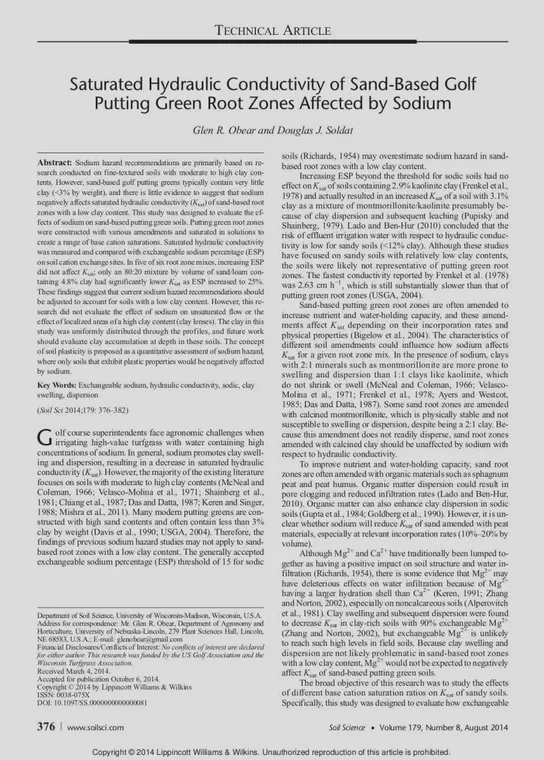Is sodium an imaginary problem?
On sand putting greens, it is. The problem caused by sodium is a reduction in the downward movement of water in soils. This is caused by the deflocculation of clay in the soil. It is a real problem in soils with appreciable amounts of clay, and in those soils, an exchangeable sodium percentage (ESP) of 15% or more is indicative of potential problems. The solution? Add gypsum to reduce the ESP, and add water to leach the sodium.
But in sand rootzones, what happens when there is a high ESP? Obear and Soldat wrote about this in Saturated Hydraulic Conductivity of Sand-based Golf Putting Green Root Zones Affected by Sodium.

In this experiment, they constructed 6 sand rootzones; 5 included amendments, and 1 did not. The sand was mixed with each amendment in a 4:1 ratio by volume—4 parts sand, 1 part amendment.
- Nonamended sand
- Sand + peat humus
- Sand + Profile
- Sand + sphagnum peat
- Sand + silt loam
- Sand + loam
Then, “the soil cores were placed in plastic tubs and allowed to equilibrate for 48 h in a range of solutions of differing ratios of sodium chloride, calcium chloride, magnesium chloride, and potassium chloride.” These solutions ranged in sodium adsorption ratio (SAR) from 0 to infinity, including two solutions with high sodium (37 mmol/L and 185 mmol/L, respectively) and no calcium, magnesium, or potassium.
After these equilibrations in solutions of different SAR, each of the soils had some cores with ESP < 15%, and some with ESP > 15%. How did the sodium influence the saturated hydraulic conductivity (Ksat) of the soils? It didn’t do much, except for the sand mixed with loam, which had a clay content by weight of 4.8%. In the unamended sand, sand mixed with peat, or Profile, or silt loam, increasing ESP did not reduce Ksat. In fact, in the unamended sand, the Ksat actually increased after the soil was equilibrated with high SAR solutions.
These are some key results:
In the case of sand-based golf course putting green root zones, which often have very low clay contents, increasing ESP well above the standard sodicity threshold of 15 had no effect on Ksat.
The application of soil amendments for remediation of sodic soils (e.g., gypsum) would only be warranted for sodic soils with higher clay contents and may not provide significant infiltration benefits to sand-based golf course putting greens.
This study also provides evidence that increasing exchangeable Mg2+ [magnesium] does not affect Ksat of sand root zones.